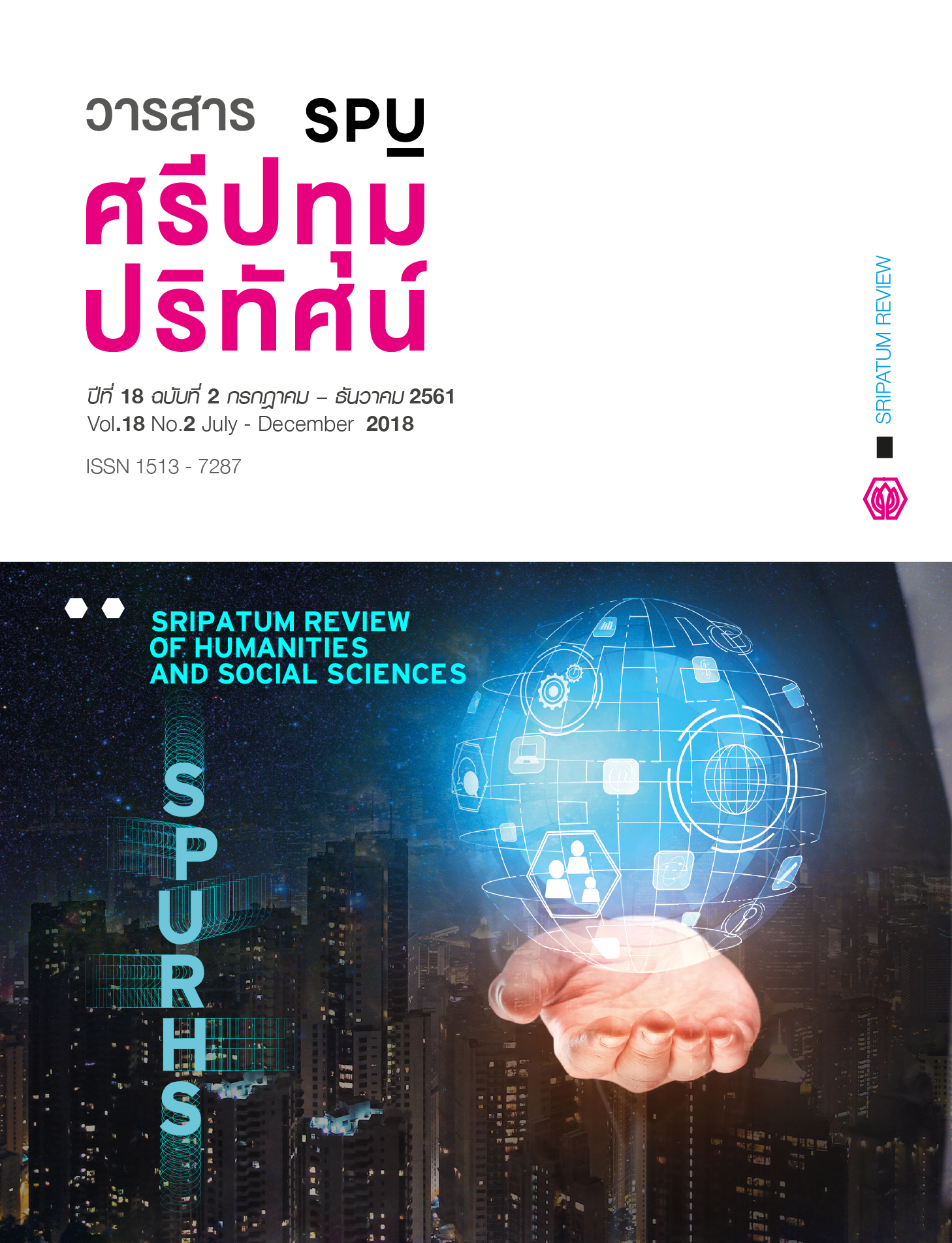FACTORS AFFECTING TO PARTICIPATION OF STUDENTS AT RAJAMANGALA UNIVERSITY OF TECHNOLOGY ISAN SAKONNAKHON CAMPUS IN ENVIRONMENTALLY FRIENDLY
Main Article Content
Abstract
The purpose of this research was to study factors affecting participation of students at Rajamangala University of Technology Isan Sakon Nakhon Campus in activities friendly to environment. The sample consisted of 400 students in Rajamangala University of Technology Isan Sakon Nakhon Campus, obtained by multi-stage random sampling. The research tool was a questionnaire. Data were analyzed with the structural equation model using the AMOS Program.
Results indicated that the developed model of relationships among factors affecting participation of students in activities friendly to environment was consistent with the empirical data. Goodness of fit statistics were =1.298, P-value = .255, CFI = 1.00, GFI = .999, AGFI = .974, RMSEA = .027, SRMR = .002. The variables in the proposed model accounted for 74.60 percent of the total factors of participation in activities friendly to environment. Six factors having both direct and in-direct influences at the .05 level of statistical significance were identified as follows: initiation, collaboration, information exchange, attitude, perception, and responsibility.
Article Details
1. กองบรรณาธิการสงวนสิทธิ์ในการพิจารณาและตัดสินการตีพิมพ์บทความในวารสาร
2. บทความทุกเรื่องจะได้รับการตรวจสอบทางวิชาการโดยผู้ทรงคุณวุฒิ แต่ข้อความและเนื้อหาในบทความที่ตีพิมพ์เป็นความรับผิดชอบของผู้เขียนแต่เพียงผู้เดียว มิใช่ความคิดเห็นและความรับผิดชอบของมหาวิทยาลัยศรีปทุม
3. การคัดลอกอ้างอิงต้องดำเนินการตามการปฏิบัติในหมู่นักวิชาการโดยทั่วไป และสอดคล้องกับกฎหมายที่เกี่ยวข้อง
References
จินตวีร์ เกษมศุข. 2554. การสื่อสารกับการเปลี่ยนแปลงของสังคม. กรุงเทพฯ : จุฬาลงกรณ์มหาวิทยาลัย.
ยุวัฒน์ วุฒิเมธี. 2526. หลักการพัฒนาชุมชนและการพัฒนาชนบท.กรุงเทพฯ: ไทยอนุเคราะห์ไทย.
สถาบันธรรมรัฐเพื่อการพัฒนาสังคมและสิ่งแวดล้อม. 2555. จับกระแส Rio+20 สู่สังคมไทย. กรุงเทพฯ: สถาบันธรรมรัฐเพื่อการพัฒนาสังคมและสิ่งแวดล้อม.
สมลักษณา ไชยเสริฐ. 2549. การพัฒนาชุมชน. กรุงเทพฯ : โอเดียนสโตร์.
สุภมาส อังศุโชติ, สมถวิล วิจิตรวรรณา และ รัชนีกูล ภิญโญภานุวัฒน์. 2554. สถิติวิเคราะห์ สำหรับการวิจัยทางสังคม ศาสตร์และพฤติกรรมศาสตร์: เทคนิคการใช้โปรแกรม LISREL. พิมพ์ครั้งที่ 3. กรุงเทพฯ: เจริญดีมั่นคงการพิมพ์.
Ackley, C. R. 2009. “Leadership in green schools: School principals as agents of social responsibility” Doctoral Dissertation, Faculty of Education, Graduate School, The Pennsylvania State University.
Aiken, L. R. 2003. Psychological testing and assessment. 11th.ed. Boston: Allyn and Bacon.
Alshuwaikhat, H.M., Abubakar, H., 2008. “An integrated approach to achieving campus sustainability: assessment of the current campus environmental management practices.” Journal of Cleaner Production, 16 (16), 1777-1785.
Disterheft, A., Caeiro, S.S., Ramos, M.R., Azeiteiro, U.M.M., 2012. “Environ-mental Management Systems (EMS) implementation processes and prac-tices in European higher education institutions a top-down versus participatory approaches.” Journal of Cleaner Production, 31, 80-90.
Geng, Y., Liu, K., Xue, B., and Fujita, T. 2013. “Creating a “green university” in China:a case of Shenyang University.” Journal of Cleaner Production, 61, 13-19.
Jorge, M. L., Madueño, J. H., Calzado Cejas, M. Y., and Andrades Peña, F, J. 2015. “An approach to the imple -mentation of sustainability practices in Spanish universities” Journal of Cleaner Pro-duction, 106, 34-44.
Karpudewan, M., Ismail, Z.H., & Mohamed, N. 2009. “The integration of green chemistry experiments with sustain-able development concepts in pre-service teachers’ curriculum: ex-periences from Malaysia.” Interna-tional Journal of Sustainability in Higher Education, 10 (2), 118-135.
Lukman, R., Tiwary, A. and Azapagic, A. 2009. “Towards greening a university campus: The case of the University of Maribor, Slovenia.” Resources, Con-servation and Recycling, 53, 639–644.
Mitchell, R.C., 2011. “Sustaining change on a Canadian campus: preparing Brock University for a sustainability audit.” International Journal of Sustainability in Higher Education, 12 (1), 7-21.
Pacheco-Blance, B., and Bastante-Ceca, M. J. 2016. “Green public procurement as an initiative for sustainable con-sumption. An exploratory study of Spanish public univerisities.” Journal of Cleaner Production, 133, 648-656.
Panjaitan, T. W. S., and Sutapa, I. N. 2010. “Analysis of green product knowledge, green behavior and green consumers of Indonesian students (case study for universities in Surabaya)”. Industrial Engineering and Engineering Management, 2268-2272.
Roy, R., Potter, S. & Yarrow, K. 2008. “Designing low carbon higher education systems Environmental impacts of campus and distance learning systems.” International Journal of Sustainability in Higher Education, 9, 116-130.
Ryan-Fogarty, Y., O’Regan, B., and Moles, R. 2016. “Greening healthcare: systematic implementation of environmental programmes in a university teaching hospital.” Journal of Cleaner Production, 126, 248-259.
Schumacker, R. E., & Lomax, R. G. 1996. A Beginner’s Guide to Structural Equation Modeling. New Jersey: Lawrence Erlbaum.
Wright, T. 2002. “Definitions and frameworks for environmental sustainability in higher education.” International Journal of Sustainability in Higher Education, 3 (3), 203-220.
Yang, Q. 2010. “The research and practice on the planning of green college campus.” Master’s Thesis, Southwest Jiaotong University.
Yuan, X., Zuo, J., & Huisingh, D. 2013. “Green Universities in China- what mattersM.” Journal of Cleaner Production, 61, 36-45.
Zhao, W., and Zou, Y. 2015. “Green university initiatives in China : a case of Tsinghua University”. International Journal of Sustainability in Higher Education,16 (4), 491-506.


